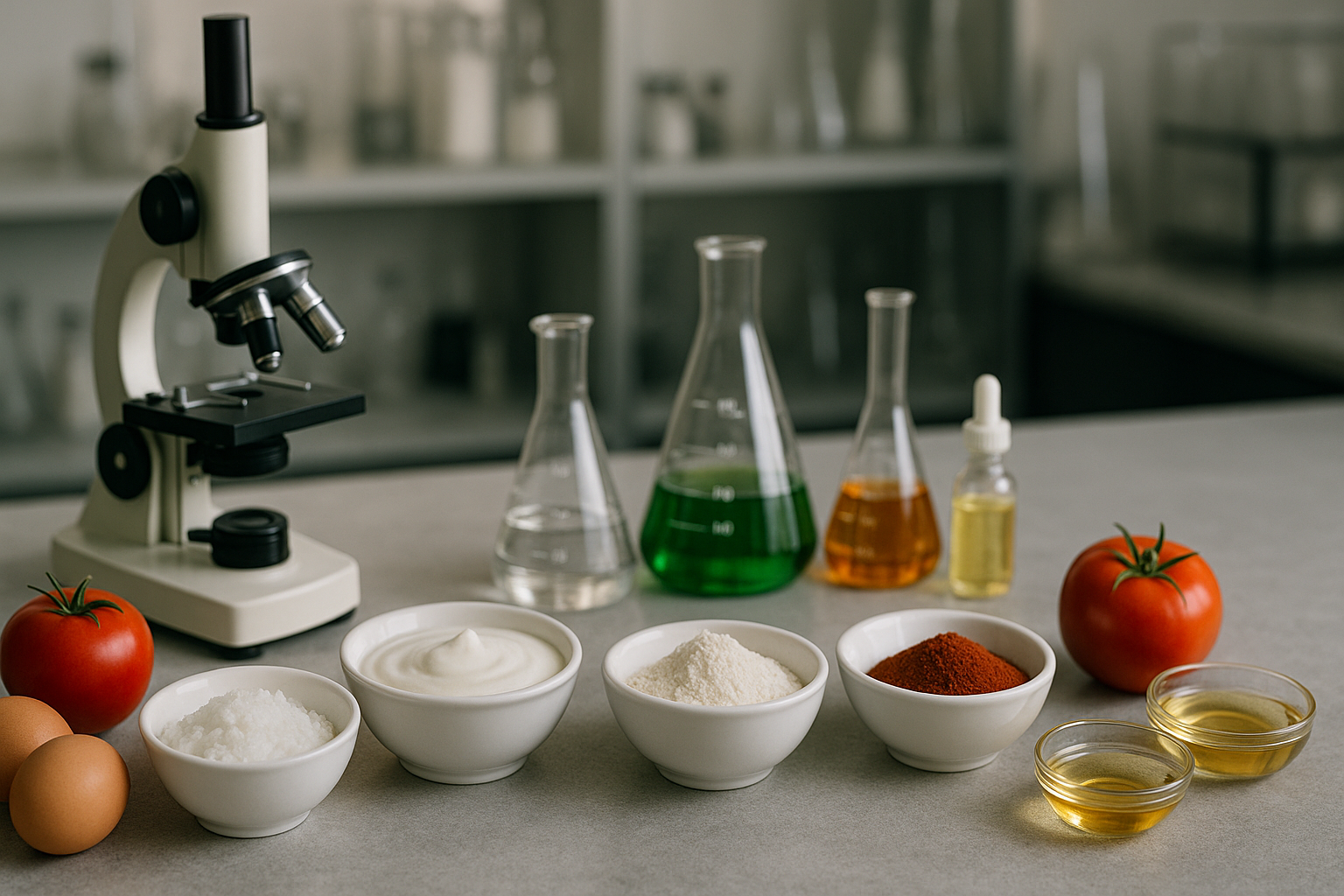Introduction
Carrageenan is a family of hydrocolloids derived from red seaweed, prized for their gelling, stabilizing, and thickening abilities. Among its different forms, Kappa Carrageenan is best known for creating firm, brittle gels, especially in dairy and meat applications. This guide explains what Kappa Carrageenan is, how it’s made, and why it is so widely used in modern food science.
Table of Contents
Quick Answers About Kappa Carrageenan
How is Kappa Carrageenan Made?
Culinary Uses of Kappa Carrageenan
Benefits & Functional Properties
Where to Buy Kappa Carrageenan
Quick Answers About Kappa Carrageenan
How does Kappa carrageenan differ from Iota and Lambda?
Kappa forms firm, brittle gels in the presence of potassium ions. Iota makes elastic gels with calcium, while Lambda does not gel but thickens liquids.
Is Kappa carrageenan safe?
Yes. Kappa carrageenan is recognized as safe when used in food. It’s approved by major food safety authorities worldwide.
What concentration is typically used?
Generally 0.2–1.0% depending on the application, with potassium salts enhancing gel strength.
Does Kappa carrageenan affect flavor?
No. It is flavor-neutral, so it doesn’t alter taste in foods or beverages.
Is Kappa carrageenan vegan?
Yes. It’s derived from red seaweed and is fully plant-based.
What foods commonly use Kappa carrageenan?
Chocolate milk, processed cheese, meat products, gummies, and vegan cheese often rely on Kappa for texture and stability.
What is Carrageenan (Kappa)?
Kappa carrageenan is a sulfated polysaccharide extracted from red seaweed, particularly Kappaphycus alvarezii. It forms strong, brittle gels when combined with potassium ions and is widely used in dairy, confectionery, and meat products. Its ability to interact with milk proteins makes it ideal for stabilizing chocolate milk and processed cheese.
How is Kappa Carrageenan Made?
- Harvesting: Red seaweed, mainly Kappaphycus alvarezii, is collected.
- Extraction: The carrageenan is extracted using hot water or alkaline solutions.
- Precipitation: Alcohol or potassium salts are added to isolate the kappa fraction.
- Drying & Milling: The purified carrageenan is dried and ground into a fine powder.
Culinary Uses of Kappa Carrageenan
- Dairy Products: Stabilizes chocolate milk, ice cream, and processed cheese.
- Confectionery: Used in gummies and firm gels.
- Meat Products: Improves water retention and texture in processed meats.
- Plant-Based Foods: Creates firm textures in vegan cheeses and desserts.
- Molecular Gastronomy: Forms creative gels for plated presentations.
Benefits & Functional Properties
- Firm Gels: Creates strong, brittle gels with potassium salts.
- Protein Interaction: Binds with milk proteins, stabilizing dairy systems.
- Moisture Retention: Improves juiciness in meat products.
- Versatile Applications: Works in dairy, meat, confections, and vegan recipes.
- Plant-Derived: Vegan, gluten-free, and widely approved for food use.
Where to Buy Kappa Carrageenan
Cape Crystal Brands offers premium Kappa Carrageenan for culinary, food production, and modern gastronomy.
👉 Shop Kappa Carrageenan Now
Carrageenan at a Glance: Kappa vs Iota vs Lambda
Full Companion Table| Property | Kappa | Iota | Lambda |
|---|---|---|---|
| Primary role | Firm, brittle gels | Soft, elastic gels | Thickener (non-gelling) |
| Ions that help | Potassium (K⁺) | Calcium (Ca²⁺) | — |
| Texture / bite | Strong, brittle, clean cut | Elastic, cohesive | Smooth, creamy viscosity |
| Syneresis (weeping) | Can occur | Low (good water retention) | N/A (no gel) |
| Typical use level | 0.2–1.0% | 0.2–1.0% | 0.1–0.5% |
| Best for | Chocolate milk, processed cheese, gummies, vegan cheese | Dairy desserts, gummies, sauces, vegan cheeses | Chocolate milk, protein shakes, dressings, syrups |
| Notes | Interacts with milk proteins; K⁺ boosts gel strength | Resists syneresis; flexible gels with Ca²⁺ | Non-gelling; great for smooth, stable viscosity |
Hydrocolloid–Ion Dependency at a Glance
Full Companion Table| Hydrocolloid | Key Ion Dependency | Notes |
|---|---|---|
| Kappa Carrageenan | Potassium (K⁺) | Forms firm, brittle gels; dairy applications benefit from K⁺. |
| Iota Carrageenan | Calcium (Ca²⁺) | Creates soft, elastic gels with good freeze–thaw stability. |
| Alginate | Calcium (Ca²⁺) | Instant gelation in presence of Ca²⁺; used for spherification. |
| Pectin (Low Methoxyl) | Calcium (Ca²⁺) | Gels in low-sugar systems; Ca²⁺ cross-links the polymer chains. |
| Lambda Carrageenan | — | Does not gel; functions only as a thickener and stabilizer. |
Not all hydrocolloids behave the same way. Some are best for building viscosity and stabilizing liquids, while others are true gelling agents that create firm or elastic structures. A few can do both, depending on the partners they’re combined with. The table below highlights the difference between thickening and gelling functions at a glance:
Thickening vs Gelling Function of Hydrocolloids
Full Companion Table| Hydrocolloid | Primary Function | Notes |
|---|---|---|
| Xanthan Gum | Thickener / Stabilizer | Shear-thinning; excellent for sauces and dressings. |
| Guar Gum | Thickener | Adds viscosity in cold and hot systems; synergizes with xanthan gum. |
| Locust Bean Gum | Thickener + Gel Synergist | Alone it thickens; forms gels in synergy with carrageenan or xanthan. |
| Carrageenan (Kappa) | Gelling Agent | Firm, brittle gels; works with potassium and dairy proteins. |
| Carrageenan (Iota) | Gelling Agent | Forms soft, elastic gels with calcium; good freeze–thaw stability. |
| Agar | Gelling Agent | Strong, brittle gels; sets at high temp and remains stable when reheated. |
| Pectin (HM) | Gelling Agent | Gels with sugar + acid; used in jams and jellies. |
| Pectin (LM) | Gelling Agent | Forms gels with calcium; ideal for low-sugar products. |
One of the most common questions chefs and food developers ask is whether a gelling agent is vegan-friendly. While some, like gelatin, are animal-derived, most modern hydrocolloids come from plants or microbial fermentation. Here’s a quick guide to which are vegan and which are not:
Vegan vs Non-Vegan Gelling Agents
Full Companion Table| Gelling Agent | Vegan? | Notes |
|---|---|---|
| Gelatin | ❌ Non-Vegan | Animal-derived from collagen; common in gummies, marshmallows, and desserts. |
| Agar-Agar | ✅ Vegan | Seaweed-derived; creates firm, brittle gels; common gelatin substitute. |
| Carrageenan (Kappa/Iota/Lambda) | ✅ Vegan | Extracted from red seaweed; versatile gelling and thickening functions. |
| Pectin | ✅ Vegan | Fruit-derived (citrus peel, apple pomace); essential in jams and jellies. |
| Gellan Gum | ✅ Vegan | Produced by microbial fermentation; creates clear, stable gels. |
| Alginate | ✅ Vegan | Seaweed-derived; gels with calcium; key in molecular gastronomy (spherification). |
Frequently Asked Questions
How does Kappa carrageenan differ from Iota and Lambda?
Kappa forms firm, brittle gels with potassium; Iota forms soft, elastic gels with calcium; Lambda thickens but does not gel.
Is Kappa carrageenan safe?
Yes, it is widely recognized as safe when used in food applications.
What concentration is typically used?
Usually 0.2–1.0% depending on the food system.
Does it affect flavor?
No, Kappa carrageenan is flavor-neutral.
Is Kappa carrageenan vegan?
Yes, it is seaweed-derived and plant-based.
What foods commonly use Kappa carrageenan?
Chocolate milk, cheese, gummies, meat products, and vegan cheese.





